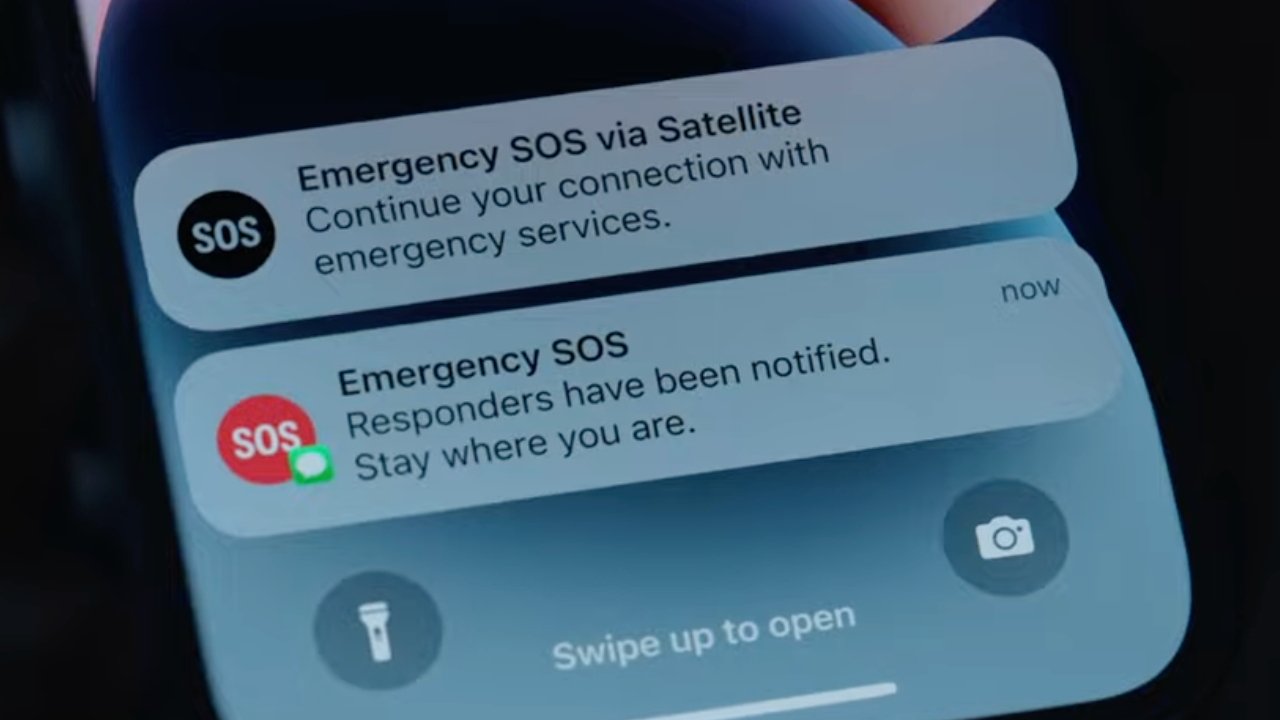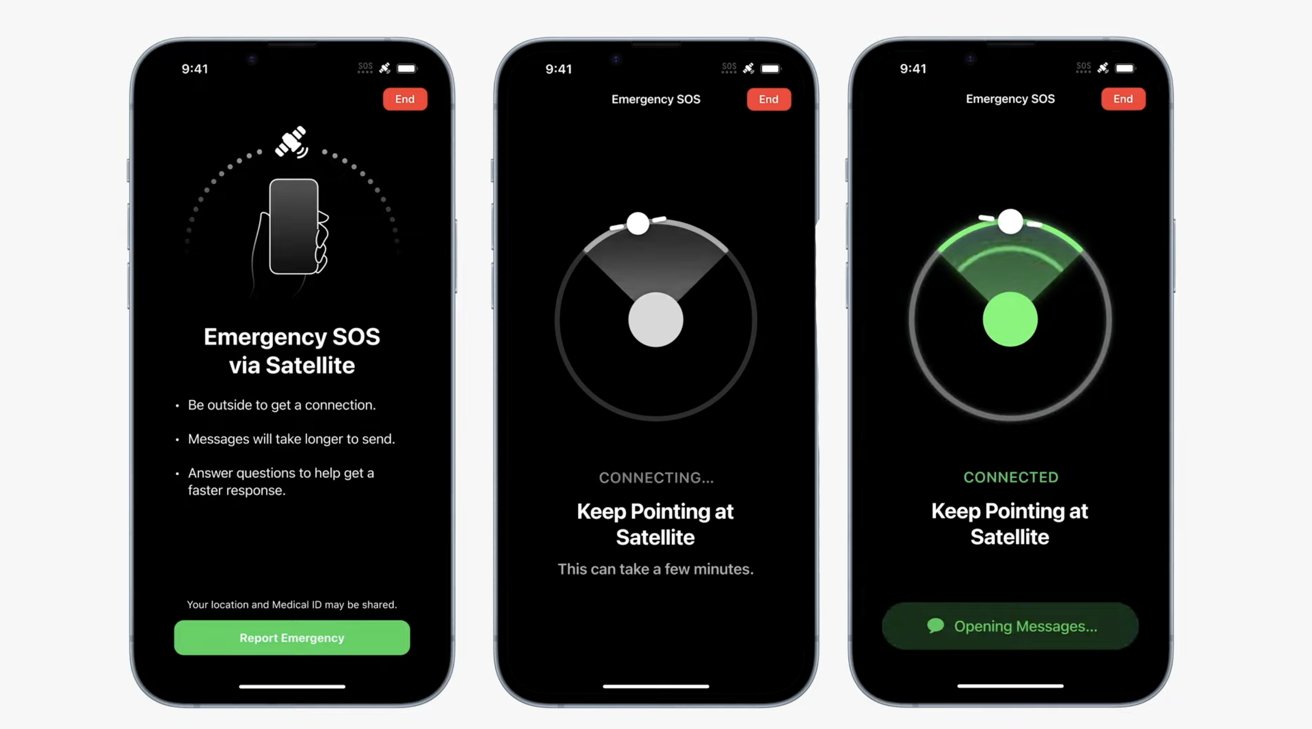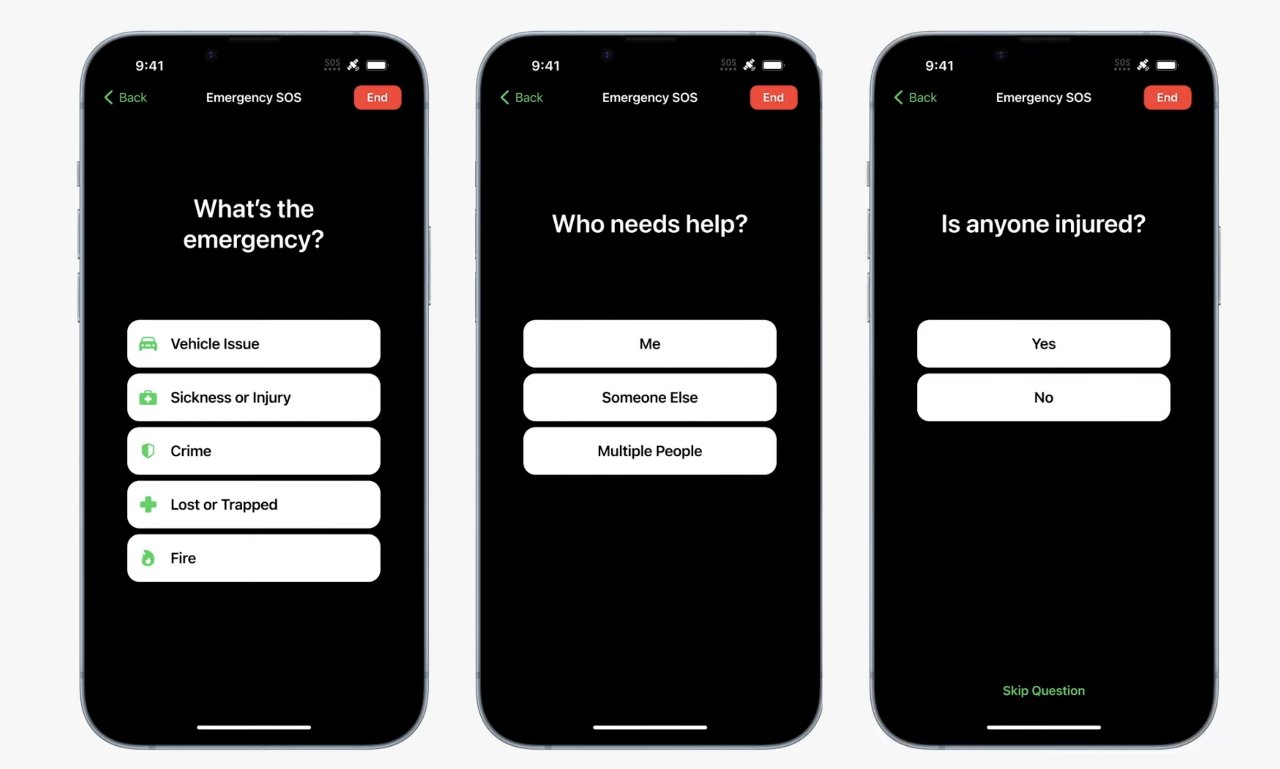How Apple's iPhone 14 emergency satellite service works for users
Apple has introduced Emergency SOS via Satellite for iPhone 14, and it's an impressive mix of both technology and new infrastructure, presented as simply as possible.

Apple says that it's taken years to get its new satellite communications service running, and it's clearly true. Launching in November, it's a major operation for Apple that did not stop with engineers finishing their designs.
Instead, to make a seamless system that helps anyone in distress, Apple had to invent new technologies -- and establish entire call centers manned by trained people.
Similarly, you can go to Messages to text 911.
If you can't reach the emergency services through either method, because there is no signal, Apple will now have an option in the Phone app for emergencies. It's not clear yet whether the option will always be available, or solely when no signal is being received.
Either way, when you do have the option, it will appear at bottom right of the phone app's screen. The app will also be displaying a warning about there being "no connection," and recommending that you "try Emergency Text via Satellite."
Tap that button, and then Apple begins taking you through the process of connecting to help via satellite. Behind the scenes, it is far from a straightforward process, but Apple does make it remarkably easy, in theory.
In practice, the options Apple gives you are remarkably well thought out, but you can still be in a location where just sending one text takes minutes.
"Unlike stationary cell towers, communication satellites are hundreds of miles above the Earth and flying over 15,000 miles per hour," said Ashley Williams, manager, Satellite Modeling and Simulation at Apple. "To connect to these satellites, you need to be outside with a clear view of the sky."
"And the bandwidth is so limited that even sending a text message is a technical challenge," she said.

Apple makes it as simple as possible to locate a satellite
From the user's perspective, the problem is how to find a satellite and then correctly point the iPhone 14 at it.
"Satellites fly too high to be seen by the human eye," continued Williams. "So we created a unique user experience that shows you where to point your phone to establish a connection and stay connected as the satellite moves."
During such an emergency call, you are prompted to point your iPhone toward a satellite and there's a Compass-like on-screen guide. It's difficult to keep that connection, but once you've found the satellite, the guide helps you stay pointed at it.
We'll be talking about the physics of this, and why Apple chose this implementation, in the future.
"So we created a custom short text compression algorithm to reduce the average size of messages by a factor of three," said Williams. "Thanks to his algorithm, it can take less than 15 seconds to send a message if you have a clearer view of the sky."
"[Under] other conditions such as like foliage, it may take a few minutes," she said. "And since each message can take some time, we know a standard back and forth conversation would take far too long for an emergency situation."
Rather than sending a general message calling for help, then answering the emergency responders' questions one at a time, Apple has worked to cut down how much a user has to be asked.
While connecting to the satellite and waiting as the text message goes, Apple's new service will ask you questions. Derived from working with emergency experts, the questions cover everything that a responder is likely to need to know.

By prompting a user with typical emergency response questions, the iPhone can compile the answers into one text
The questions also come with the most common answers, so someone in distress can tap a button instead of trying to type.
All of the answers are gathered by the iPhone and sent in one go.
"With fewer messages to write and send you can get help quicker after a message is relayed to ground station and needs to reach the right emergency service provider," said Williams.
The reason is that some emergency services are still not geared up to respond to text messages.
"If that emergency service provider accepts text messages, we will connect you to them directly," says Williams. "If they only accept voice calls, we have set up relay centers staffed with highly trained emergency specialists ready to get your text and call an emergency service provider on your behalf."
"We believe that this service is such an essential part of the iPhone experience that will include it free for two years with iPhone 14," said Kaiann Drance, Apple's vice president of iPhone Product Marketing.
It's not yet clear what that cost will be after the two years. And, we hope that it's accessible to all, with payment after-the-fact if necessary.
Emergency SOS via Satellite will initially be available to users in the US and Canada. It launches in November 2022.
Competitors are planning satellite communications services for cell phones, such as the partnership between T-Mobile and SpaceX. However, their service will not even go into beta testing before the end of 2023, and there is no detail at all about satellite finding, or human relay centers.
Read on AppleInsider

Apple says that it's taken years to get its new satellite communications service running, and it's clearly true. Launching in November, it's a major operation for Apple that did not stop with engineers finishing their designs.
Instead, to make a seamless system that helps anyone in distress, Apple had to invent new technologies -- and establish entire call centers manned by trained people.
What the user sees at first
The new Emergency SOS via Satellite is not a new Apple app, nor is it always available on iPhones. Apple recommends that if you have an emergency, you first try making a regular call to 911.Similarly, you can go to Messages to text 911.
If you can't reach the emergency services through either method, because there is no signal, Apple will now have an option in the Phone app for emergencies. It's not clear yet whether the option will always be available, or solely when no signal is being received.
Either way, when you do have the option, it will appear at bottom right of the phone app's screen. The app will also be displaying a warning about there being "no connection," and recommending that you "try Emergency Text via Satellite."
Tap that button, and then Apple begins taking you through the process of connecting to help via satellite. Behind the scenes, it is far from a straightforward process, but Apple does make it remarkably easy, in theory.
In practice, the options Apple gives you are remarkably well thought out, but you can still be in a location where just sending one text takes minutes.
"Unlike stationary cell towers, communication satellites are hundreds of miles above the Earth and flying over 15,000 miles per hour," said Ashley Williams, manager, Satellite Modeling and Simulation at Apple. "To connect to these satellites, you need to be outside with a clear view of the sky."
"And the bandwidth is so limited that even sending a text message is a technical challenge," she said.

Apple makes it as simple as possible to locate a satellite
From the user's perspective, the problem is how to find a satellite and then correctly point the iPhone 14 at it.
"Satellites fly too high to be seen by the human eye," continued Williams. "So we created a unique user experience that shows you where to point your phone to establish a connection and stay connected as the satellite moves."
During such an emergency call, you are prompted to point your iPhone toward a satellite and there's a Compass-like on-screen guide. It's difficult to keep that connection, but once you've found the satellite, the guide helps you stay pointed at it.
We'll be talking about the physics of this, and why Apple chose this implementation, in the future.
Text messages only, no voice calls
The only communication that can be done via satellite is text messaging. Even this is more involved behind the scenes than texting is with regular carriers, and the visible upshot of this is that it takes much longer to send even short messages."So we created a custom short text compression algorithm to reduce the average size of messages by a factor of three," said Williams. "Thanks to his algorithm, it can take less than 15 seconds to send a message if you have a clearer view of the sky."
"[Under] other conditions such as like foliage, it may take a few minutes," she said. "And since each message can take some time, we know a standard back and forth conversation would take far too long for an emergency situation."
Rather than sending a general message calling for help, then answering the emergency responders' questions one at a time, Apple has worked to cut down how much a user has to be asked.
While connecting to the satellite and waiting as the text message goes, Apple's new service will ask you questions. Derived from working with emergency experts, the questions cover everything that a responder is likely to need to know.

By prompting a user with typical emergency response questions, the iPhone can compile the answers into one text
The questions also come with the most common answers, so someone in distress can tap a button instead of trying to type.
All of the answers are gathered by the iPhone and sent in one go.
"With fewer messages to write and send you can get help quicker after a message is relayed to ground station and needs to reach the right emergency service provider," said Williams.
The human element in the background
Apple talked about all of the technology that it had to put in place for this service to exist, and it did not mention the satellite deals it had to do. Alongside all of this, though, Apple has also put in place relay centers and it has trained its own staff to man them.The reason is that some emergency services are still not geared up to respond to text messages.
"If that emergency service provider accepts text messages, we will connect you to them directly," says Williams. "If they only accept voice calls, we have set up relay centers staffed with highly trained emergency specialists ready to get your text and call an emergency service provider on your behalf."
The service you never want to use
Like crash detection on the iPhone and Apple Watch, this emergency service feature is one that nobody would wish to need. But when you do need it, Apple's new solution is deeply worked out and remarkable."We believe that this service is such an essential part of the iPhone experience that will include it free for two years with iPhone 14," said Kaiann Drance, Apple's vice president of iPhone Product Marketing.
It's not yet clear what that cost will be after the two years. And, we hope that it's accessible to all, with payment after-the-fact if necessary.
Emergency SOS via Satellite will initially be available to users in the US and Canada. It launches in November 2022.
Competitors are planning satellite communications services for cell phones, such as the partnership between T-Mobile and SpaceX. However, their service will not even go into beta testing before the end of 2023, and there is no detail at all about satellite finding, or human relay centers.
Read on AppleInsider

Comments
I am upgrading from my 13 pro for this alone. Of course the extra battery life is good too
also anyone saying Starlink and T-Mobile would be better etc. I use T-Mobile and love Elon but what they discussed that day was vaporware, likely 1 or 2 years away. And you can be sure T-Mobile will be requiring users to be in the most expensive plan and likely also pay per use on top of it
That phone was scheduled for release last year but delayed after Huawei had to re-jig its supply chain after US sanctions. The satellite feature would be old news if it had released on schedule. It is said that next year things will be back to normal with the two flagship series yearly cycle.
I would think most of the bigger players will be onboard pretty soon. From there things will be fleshed out in terms of functionality.
That Apple has incorporated simple PLB functions into a smartphone is noteworthy and laudable, but satellite SOS has been around for years. Those of us who are hikers and backcountry explorers have carried devices like the InReach, SPOT, Zoleo, etc for a while. They're small, have battery life measured in weeks, and often allow for more flexible communication (like arbitrary text messaging to any recipient, not just emergency SOS), but require their own monthly subscription, obviously.
It will be interesting to see what Apple ends up charging for this service after the initial two years are up. Simple PLB devices (basically a big red SOS button with GPS and satellite connectivity) run around $10 a month, give or take. Once you get into a true satellite messenger like an InReach, costs can climb from $15 to $50 a month or more. If Apple expands their services' capabilities over time to include more robust messaging, it could be a very compelling alternative. Although I personally don't know that I'd want to rely on a comparatively fragile smartphone when I'm out in the boonies. But, YMMV.
And yes, it's worth noting that Apple went with Globalstar with its relatively small satellite constellation (and significant dead zones), versus a 100 percent coverage constellation like Iridium. That will hamper Apple's ability to expand it beyond North America (assuming they don't end up contracting with Iridium or Starlink down the line).
As for it having been old news if it had released on schedule -- well yeah, that's how it works for everybody. But here in our shared reality, that didn't happen.
"How Apple's iPhone 14 emergency satellite service works" would have been fine.
I was simply pointing out a fact.
The delay in release had literally nothing to do with the pandemic, labor issues etc.
It was 100% due to sanctions. That is it. Plain and simple.
Can you name any other flagship manufacturer that found itself having to do the same?
No. Of course you can't. They all had labor issues, supply chain disruption and pandemic problems but their release schedules were not put back by a whole year.
I'm not talking about ol' Uncle Sam in a political tone. I'm talking about supply chain re-jigging due to sanctions and the resulting delay and yes, that phone is basically last year's phone but can still hold its own on many fronts even with a 12 month delay.
it’s already amazing Apple is giving this out for free for 2 years for emergencies
just by doing this, Apple is contributing to better peoples lives . I am grateful ! Something the butt head politicians can learn from instead of trying to destroy apple with their corrupt Justice department
Traditional satellite phones have large external antennas and still aren't terribly reliable.